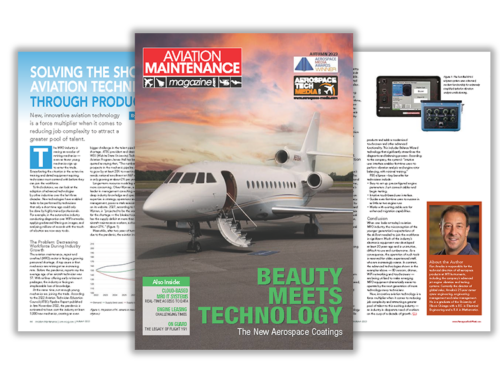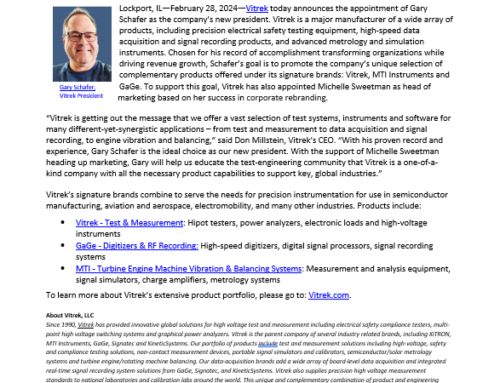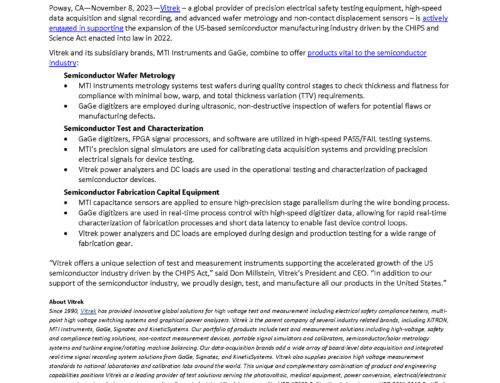With 2019 upon us, we know everyone is thinking about what’s next in the Test and Measurement industry. We also know that without test and measurement equipment, engineers can’t accurately and consistently prove that their mechanical or electronic devices perform as required. When they don’t work, engineers also need to determine why and how to fix them.
All of this leads to innovative thinking on how to test and measure even better by taking advantage of rapidly growing trends such as digitization, software, additive manufacturing, the Internet of Things (IoT), and new sensing applications that are driving advances in T&M.

Digitization
Increasingly, sensors are providing digital outputs instead of analog ones. Traditional analog outputs such as 4-20 mA are accurate and reliable, but digital outputs provide distinct advantages. For example, digital sensors can incorporate high transfer rates, high transmitter reliability, and self-diagnostic tools. Engineers also like how they can plug-in or replace digital devices without interrupting the overall system.
Digital outputs are providing advantages in terms of wiring, too. For example, bus-compatible sensors allow for longer cable lengths and cables of varying lengths between sensors and the data acquisition system. Multiple digital sensors can also use the same cable, which reduces wiring costs. Importantly, digitization is supporting wireless communications.
Electronic contract manufacturers like SHINE Wire in Adams, Massachusetts are benefitting from the ensuing growth in sensor demand.

Software
More vendors are also supplying application software for the sensors that they make. Writing sensor code from scratch is both difficult and time-consuming, which is why many operating systems already provide some level of support. For example, Windows provides native support for sensor devices and includes an application programming interface (API) for connected sensors and sensor data.
In addition to API, sensor tools can include sample source code that speeds development and command line utilities that read samples from evaluation boards. As sensor software matures, more vendors will provide easy-to-use interfaces and data exports. User-adjustable settings for range, filter, data rate, and other parameters will enhance the T&M engineer’s efforts.
The future of sensors and software doesn’t end there, however. Kalev Leetaru, a Senior Fellow at the George Washington University Center for Cyber & Homeland Security, recently warned in Forbes that “we need software that doesn’t panic when sensors malfunction.” As software developers learn to build more resilient systems, look for software algorithms to cope more intelligently with errant sensors.

Additive Manufacturing
Additive manufacturing, or 3D printing (3DP), will continue to support advances in sensor technologies. For example, during last summer’s Sensors Expo event in San Jose, participants learned about research into a screen-printed potentiometric sensor with a porous 3D printed housing. This hybrid device is still in its infancy, but international researchers are now leveraging 3DP to study the sense of touch in babies.
Recently, RPI CATS produced a 3D-printed plastic housing for an acoustic sensor. “The geometry of the housing is critical to the sensor’s function and would have difficult to make using conventional methods,” Rock says. For parts that are “difficult, complex, or expensive to machine,” additive manufacturing’s benefits become clear. A component in GE Aviation’s GE90-94B jet engine proves Rock’s point.
Several years ago, the Federal Aviation Administration (FAA) approved the first 3D printed part to fly in a commercial jet engine. Known as the T25, the metallic housing for the compressor inlet temperature sensor is made from a cobalt-chrome alloy that can withstand extreme temperatures and airflows. This 3DP part isn’t the sensor element, but sensors like thermocouple junctions may be 3D printed someday.

The Internet of Things (IoT)
IoT-enabled devices such as smart appliances and medical wearables need sensors that are smaller and more power-efficient. As the market for these technologies continues to grow, more sensors will incorporate integrated circuits (ICs) and micro-electro-mechanical systems (MEMS). Some of these sensors will also incorporate integrated processors.
5G networks will support the growth of IoT devices by increasing the speed, responsiveness, capacity, and latency of wireless communications. “5G networks will become the standard,” says Binghamton University’s Kuracina. “Data-transfer rates are expected to exceed 20 gigabits per second, requiring manufacturers to analyze and test their technologies with new methods and equipment.”
Dominic Testo, business development manager at Specialty Silicone Products in Ballston Spa, New York, supplies EMI silicones to companies like JBC Technologies. “There’s still time to prepare,” Testo says, “but designers need to understand some 5G network fundamentals.” For example, “the millimeter-waves in 5G don’t travel as far as low-frequency waves and won’t readily pass through structures.”

New Sensing Applications
T&M engineers can also expect new sensing applications in 2019. According to researchers at the Massachusetts Institute of Technology, cyborg-like devices for smart agriculture are possible. Elowan, a wheeled robot that’s attached to a plant, has embedded electrodes in the pant itself. The robot moves toward or away from a light source in response to bioelectrical signals produced by photosynthesis.
IEEE Spectrum predicts an “Internet of disposable things” with sensors made of paper or plastic and embedded in food packaging. For example, by detecting the concentration of gases associated with food decomposition, you’ll be able to tell whether the meat that’s been in the back of your refrigerator is still safe to eat. Instead of sniffing the package and hoping for the best, you’ll get an alert on your smart phone.
Finally, the future is full of promise for micro-sensor implants, self-powered sensors, biodegradable sensors, sensor swarms, and so called “smart dust” that’s powered by vibrations. For T&M engineers, these developments aren’t just all in a day’s work. If the wireless router in your house can use RF reflections to find you, what else will 2019 bring?
By Steve Melito
Manufacturing Industry Writer



